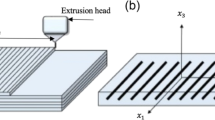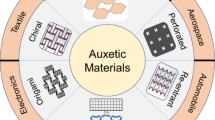Abstract
This study aims to investigate the dry sliding behaviour of the 3D-printed acrylonitrile butadiene styrene (ABS) pins which were developed using the fused filament fabrication process and showed different internal geometries under varying normal loads and sliding speeds. Results noted in this study were analysed and related to their mechanical properties. It was also supported by the findings derived after the use of the wear transition mode along with the wear mechanisms of 3D-printed ABS. It was seen that the pin with a triangular flip internal structure showed the minimum coefficient of friction (COF) value and the wear rate distribution. The wear rate and the COF values were relatively dependent to the normal loads, sliding speeds and internal geometries. However, the correlation between tribological and mechanical properties of the 3D-printed ABS pin with different internal geometries is not statistically significant. The main wear mechanisms that caused a mild and severe wear were seen to be delamination, abrasion and lower fatigue wear.












Similar content being viewed by others
References
Ford SL (2014) Additive manufacturing technology: potential implications for US manufacturing competitiveness. J Int Comp Econ 6(40):1–35
Liu Z, Wang Y, Wu B, Cui C, Guo Y, Yan C (2019) A critical review of fused deposition modeling 3D printing technology in manufacturing polylactic acid parts. Int J Adv Manuf Technol 102(9-12):2877–2889
Stansbury JW, Idacavage MJ (2016) 3D printing with polymers: challenges among expanding options and opportunities. Dent Mater 32(1):54–64
Wang X, Jiang M, Zhou Z, Gou J, Hui D (2017) 3D printing of polymer matrix composites: a review and prospective. Compos Part B 110:442–458
Saroia J, Wang Y, Wei Q, Lei M, Li X, Guo Y, Zhang K (2020) A review on 3D printed matrix polymer composites: its potential and future challenges. Int J Adv Manuf Technol 106(5-6):1695–1721
2017 Report on Emerging Issues & Trends in Tribology and Lubrication engineering. Society of Tribologist and Lubrication Engineers 1-52.
Amiruddin H, Abdollah MFB, Norashid NA (2019) Comparative study of the tribological behaviour of 3D-printed and moulded ABS under lubricated condition. Mater Res Express 6(8):085328
Gurrala PK, Regalla SP (2017) Friction and wear rate characteristics of parts manufactured by fused deposition modelling process. Int J Rapid Manuf 6(4):245–261
Sukindar NA, Ariffin M, Anwar MK, Jaafar CNA, Baharuddin BT, Ismail MIS (2017) Optimization of the parameters for surface quality of the open-source 3D printing. J Mech Eng 3(1):33–43
Ertane EG, Dorner-Reisel A, Baran O, Welzel T, Matner V, Svoboda S (2018) Processing and wear behaviour of 3D printed PLA reinforced with biogenic carbon. Advances in Tribology 2018:1763182
Jeon H, Kim Y, Yu WR, Lee JU (2020) Exfoliated graphene/thermoplastic elastomer nanocomposites with improved wear properties for 3D printing. Compos Part B 189:107912
Lin L, Ecke N, Huang M, Pei XQ, Schlarb AK (2019) Impact of nanosilica on the friction and wear of a PEEK/CF composite coating manufactured by fused deposition modeling (FDM). Compos Part B 177:107428
Ghosh S, Abanteriba S, Wong S, Houshyar S (2018) Selective laser melted titanium alloys for hip implant applications: surface modification with new method of polymer grafting. J Mech Behav Biomed Mater 87:312–324
Zhang X, Xia Y, Wang J, Yang Z, Tu C, Wang W (2015) Medial axis tree—an internal supporting structure for 3D printing. Comput Aided Geom Design 35:149–162
Galeta T, Raos P, Stojšić J, Pakši I (2016) Influence of structure on mechanical properties of 3D printed objects. Procedia Engineering 149:100–104
Norani MNM, Abdollah MFB, Abdullah MIHC, Amiruddin H, Ramli FR, Tamaldin N (2020) 3D printing parameters of acrylonitrile butadiene styrene polymer for friction and wear analysis using response surface methodology. P I Mech Eng J-J Eng 135065012092560. https://doi.org/10.1177/1350650120925601
Kiernan D (2014) Correlation and simple linear regression. In: Natural resources biometrics. Open SUNY Textbooks, New York, pp 150–181
Hatipoglu G, Kartal M, Uysal M, Cetinkaya T, Akbulut H (2016) The effect of sliding speed on the wear behavior of pulse electro co-deposited Ni/MWCNT nanocomposite coatings. Tribol Int 98:59–73
Kato K, Adachi K (2001) Wear mechanisms. In: Bushan B (ed) Modern tribology handbook. Vol I.: CRC Press LLC, New York, pp 273-300.
Acknowledgements
The authors gratefully acknowledge the contributions made by the members of the Green Tribology and Engine Performance (G-TriboE) research group, Universiti Teknikal Malaysia Melaka.
Funding
The research is supported by a grant received from the Ministry of Higher Education Malaysia [grant number FRGS/2018/FTKMP-CARE/F00385].
Author information
Authors and Affiliations
Corresponding author
Additional information
Publisher’s note
Springer Nature remains neutral with regard to jurisdictional claims in published maps and institutional affiliations.
Rights and permissions
About this article
Cite this article
Abdollah, M.F.B., Norani, M.N.M., Abdullah, M.I.H.C. et al. Synergistic effect of loads and speeds on the dry sliding behaviour of fused filament fabrication 3D-printed acrylonitrile butadiene styrene pins with different internal geometries. Int J Adv Manuf Technol 108, 2525–2539 (2020). https://doi.org/10.1007/s00170-020-05573-7
Received:
Accepted:
Published:
Issue Date:
DOI: https://doi.org/10.1007/s00170-020-05573-7




